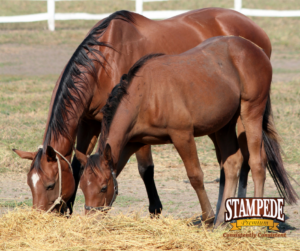Did you know that horses require to eat at minimum of one percent of their weight everyday of hay. When considering the health of a horse, you have to look at the hay quality that your horse is consuming. Imagine a horse that weighs 1000 pounds eats about 15 to 20 pounds of hay a day. That means the nutrients in the hay plays a big role in the overall health of your horse. The higher the quality of the hay the better it is for the horse’s digestive tract that allows for better nutrient absorption. There are many contributing factors that make up the nutrient content of hay. These include:
- Plant species

- Fertilization
- Time of year when hay was harvested
- Maturity at time of harvest
- Storage conditions and age
- Climate conditions
Maturity is the determining factor of quality forage. It impacts how much nutrients it has than any other influence. So basically, the younger the hay is harvested the more protein and minerals it contains. The older the hay, the less nutrients it has and is stemmier and contains more fiber. The fiber makes it hard for horses to digest which means they are not eating it. It is critical that hay is harvested at the right time to garner the vitamins horses need.
Let’s take a look at how a horse’s digestive track process hay. The protein a horse extracts from hay must pass through it’s small intestine. Therefore, the more fiber hay contains, meaning the older it is, the less protein will be absorbed since fiber must go through the large intestine.
Many horses owners think alfalfa hay may be the better forage due to its high protein content. The fertilization process has affected how much is harvested per acre versus the amount in a bale of hay. So this doesn’t necessarily mean you get more protein in alfalfa. Seasons, climate conditions, storage conditions, age of hay, all have major affects on hay quality.
Here’s what to look for when determining the quality of hay:
- High leaf-to-stem ratio
- Small diameter stems
- Few seed head or blooms
- Fresh smell and appearance
- Cleanliness (no dust, mold, weeds or trash)
- Color (a faded, yellow or brown color may indicate aged hay or poor storage conditions)
When your in short supply of nutrient rich hay make sure to get the right feed with full of protein and nutrients. Stampede Premium’s Pellets and Hay Cubes products have the right amount of those nutrients needed. Stampede Premium has been offering the best quality equine hay and equine products since 1995.
Get Hay Quality with Stampede Premium.
